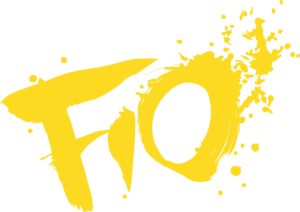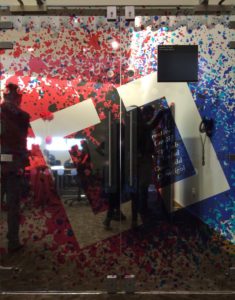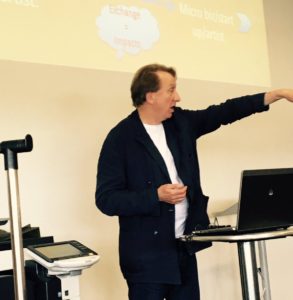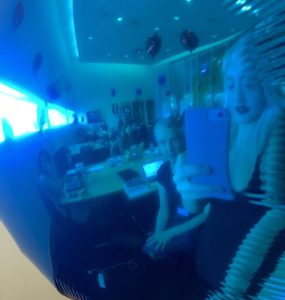
Hi Abdul, would you mind by starting by giving a quick background of yourself for our readers?
Yes of course! I moved from London to Wales in 2011 and worked for National Theatre Wales as a creative associate. In 2013 I left and started my own new projects – I created Fio from the foundations of an organisation I ran in London called Youth Of Creative Arts. Fio is based in Cardiff and is an arts charity with the aim of creating new interest in art projects and developing people within the arts.

At Fio, we want to make productions that start conversations over important issues, which can be seen with our previous productions as well as our currently-running Death and the Maiden. Fio’s motto is “Fio makes fearless theatre: work that tears down stereotypes and challenges injustice.”
Considering your move from London to Cardiff, did you personally feel that there was a need for a boost in cultural diversity in the Welsh arts scene?
When I moved to Wales I could see a hugely diverse community around me. But many culturally-diverse artists aren’t made prominent on the Welsh arts scene and aren’t given the same platforms as others. I created Fio to try and boost these people up and bring them an opportunity. Fio’s production last year, The Mountaintop, aimed to tackle race issues and how much they may or may not have changed. Despite being focused on the Black American community, it resonates across the world where there is underrepresent Afro-Caribbean community.

In a world concerned with TV, film and social media, do you worry that there is a struggle to keep theatre alive?
I don’t think theatre is going anywhere. The live nature and the fact the audience is involved in productions and are living it as the actors are has such a powerful impact. There is a bigger sense of real-life empathy that you don’t get in the same way through a screen. Therefore, theatre will not disappear. Historically, performance has always been a way to enable communities to hold a mirror up to themselves and allows them to purge themselves of some of their issues and questions. Theatre always provokes you to think about topical issues and debate. It’s a shared experience, you’re there as a group and you share the experience together.

What has it been like, being the director of a play that touches so many on a personal level? With themes like rape and abuse, there is a large responsibility placed on your shoulders.
As a production team, we are very concerned with supporting actors and audiences that could be affected by the themes the play raises. We want to talk about it but also provide a safe space for thinking around abuse and dealing with democracy after a dictatorship. Gender politics has a huge part to play in the show too. We want the production to force us to have those conversations. It’s been an interesting process as a creative team, thinking about how to do it right and how to safeguard those participating in those conversations in the first place. We want to do it in a way that is constructive. We’re going to have some Q&As with people who have experience civil war, rape and other themes of the play to enable the safe-guarded conversation. Also, on the 1st -3rd November we are running a female-only project. Fusion is meant to encourage a safe space for women to get together and respond to the personal themes we want to raise in discussions. It will be at St David’s Hall and will really delve into what being a female in wales is like.
The play is preoccupied with truth, democracy and dictatorships (as many as other themes). When regarding the world as we know it right now, what do you think topical themes such as these can do for cultural understanding of politics? Can they inspire change?
Yeah, the play tackles these themes but also tries to discuss issues on a personal level, such as abuse and raw torture. We want to ask: how does a whole nation recover with democracy after a dictatorship? How do victims move on from governmental abuse? Recent events such as the Weinstein case raises the conversation about issues such as abuse of power and the male-dominated world women have to live in. What happens when women are subjected to sexual abuse and how is it viewed through the lens of the mainstream? How can we empower women to feel like they can talk about it? We want to know how to identify and start being able to rectify issues of these nature.
Thanks for talking with me, Abdul.
Thanks.
Death and the Maiden is being shown in The Other Room, Cardiff from the 31st October until 11th November.
By Charlotte Clark
Tag Archives: Arts
Creative Cardiff Pop-Up Hub: Reflections on Hub Environments for the Arts
All images taken from social media linked to the project
In the same week that it was announced that Britain was leaving the EU, free-thinkers in Cardiff were exploring new and innovative ways for arts professionals to work together as part of the Creative Cardiff pop-up hub.
From the 20th-24th June selected creatives occupied a temporary pop-up workspace in the Wales Millennium Centre as part of an initiative organised by Creative Cardiff. Sara Pepper, director of Creative Economies at Cardiff University, was a key organiser of the event having researched existing approaches to creative hubs both within, and outside of Wales. Pepper champions ‘hub’ models as potential centres for innovation within the Cardiff creative economy. Sara Pepper has authored a blog post in which she outlines her research which you can access via the link below:
http://blogs.cardiff.ac.uk/creative-economy/2016/06/16/a-creative-hub-for-cardiff/
Creative Cardiff is an online network of practicing creatives in the Cardiff area initiated by a team at Cardiff University. The network went live in October 2015 and already currently has a membership of over 550 practitioners.
This form of online network has already proven useful to both my peers and myself, practicing within universities as well as on a freelance basis. Organisations such as EMVAN (The East Midlands Visual Arts Network) provide valuable access to creative opportunities and share relevant events information, thus implementing a meeting of like-minded practicing creatives and audiences alike.
What Creative Cardiff achieved in this recent venture is to demonstrate that the hub environment prompted an acceleration of the outputs of its occupants whilst retaining its supportive values. There are early indications that hubs may prove to be beneficial to the development of creative networks and productivity within the city. That these values could be propagated successfully within the physical space of a hub supports the demand for more dedicated collision spaces for creatives, which could support existing online networks.
“Our network aims to bring together people from across the full breadth of the city’s creative economy – from dancers and marketing professionals to architects and app developers. By collaborating and sharing ideas we want to encourage more innovation and creativity in our city” – Creative Cardiff.
Reflecting on my own experience of working in the hub, I found the pop-up nature of the arrangement provoked thought and reflection on the nature of the co-operative working arrangement rather than focusing on the development of individual creatives. This differs from the way in which arts students or employees within other creative industries are usually encouraged to practice, and on the surface seems to contradict productivity. Although the arrangement of the short-term hub might have been initially disruptive, established examples have indicated that co-operative working increases productivity – hence Google’s eagerness to provide exciting, open workspaces for their employees to work collaboratively.
I found the group was particularly concerned with how professionals from various creative fields might gather to achieve the aforementioned aims of Creative Cardiff, whilst still continuing to realise autonomous objectives within their own creative practices. Countless discussions were had on the topic, and throughout the week questions were raised regarding the benefits, physical design, core values, social and creative impact of working in this way to name but a few. Issues such as these are often interrogated on occasions where creative practice mingles with academic insight.
A particularly successful feature of the pop-up hub was the daily ‘Provocation Sessions’ provided in the mornings within the hub space. During these sessions, the hub members were invited to hear professional reflections on the nature of creative spaces and productivity and discussion on these topics was encouraged. We heard from a range of speakers including Prof. Wayne Forster of the Welsh School of Architecture, Clare Reddington and Jo Landsdowne of WATERSHED (Bristol) and Prof. Jonathan Dovey, UWE Professor of Screen Media and director of REACT. Such sessions provided an opportunity for focused learning and interaction amongst the hub members that I believed complimented more casual encounters experienced in the joint space.
I found Prof. Jonathan Dovey’s insights regarding the hub as a creative eco-system especially informative and motivational. His experience has demonstrated that hubs can provide instances of exchange, impacts and continued mutual support amongst their occupants. Dovey placed particular emphasis on the benefits of shared values within creative hubs, such as generosity, openness, trust and excitement.
It is the presence of these shared values, possessed by the members of the pop-up, which contributed towards the success of the Creative Cardiff hub, and defined the unique and progressive environment that I experienced as a member.
With the project only spanning over a short week, the conditions of the hub could not be established in the way in which an organically cultivated hub space might. However, many would agree that the potential for development and continuation of the project was evident. Through research carried out by Cardiff University, we can be positive the project has contributed to the development of creative hubs in Cardiff in the future. As well as this, I hope there is recognised potential for such hubs to become part of an interconnected network of creatives spanning Wales, the UK, and even Europe and globally.
Perhaps the potential of a hub network is way in which creatives can demonstrate that, despite established individualist tendencies, we are in fact better together.
To view Amelia’s Creative Cardiff profile, please follow the link below:
http://www.creativecardiff.org.uk/users/amelia-seren-roberts
Twitter: @amelia_seren






